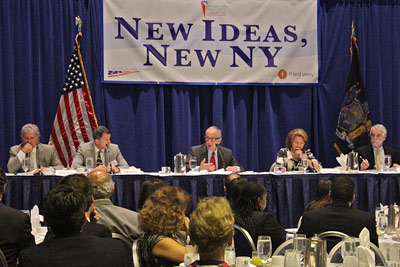Experts agree on need for partnerships to speed New York tech transfer
By Caroline Shin

Which state comes to mind as a high-tech center? California, surely, but New York is stepping up its game.
Cornell President David Skorton, who chaired the gubernatorial Task Force on Diversifying the New York State Economy Through Industry--Higher Education Partnerships in 2009, moderated a discussion Aug. 22 in New York City that reinforced the need for partnership among government, corporations and higher education.
Commercialization of new ideas from academia "would provide tremendous economic potential ... but it is one of the areas where New York is not doing well," said New York Gov. Andrew Cuomo.
We need a "cradle-to-commerce" "educational system that creates a pipeline into the economy," said panelist Linda Sanford, IBM senior vice president of enterprise transformation. IBM's Watson computer, which won on the game show "Jeopardy," was the product of collaboration between IBM and several universities, including Rensselaer Polytechnic Institute.
"Competitive research funding by federal taxpayers is the fuel for higher education-related research," said Skorton. "And university research is the engine using that fuel to lead to technology transfer."
Cornell and Columbia universities are among 25 institutions reporting the largest fiscal year 2010 research and development expenditures, with $750 million and $807 million, respectively. But in the fourth quarter of 2011, New York state secured just 10 percent of the nation's venture capital funds, compared with 12 percent for Massachusetts and 40 percent for California.
What actions can New York state take?
Seed an incubator fund, said the panelists. Fund the research-to-commerce gap, said Mark Fasciano, founder and managing director of Canrock Ventures, a seed-stage venture capital firm.
While most venture capital firms invest in companies with $5 million in sales, "we think the key is small amounts of money -- this could be 25,000, 50,000, 100,000 bucks to build that business plan," said Fasciano. "But you need to create a lot of companies to find those big hits," such as Instagram or Facebook.
Tax reform was another key issue.
The 35 percent U.S. tax rate on global sales has driven $1.5 billion offshore, said Duane Roth, CEO of CONNECT, a San Diego program that catalyzes creation of technology and life sciences companies. IBM's Sanford said globally competitive tax credits, relaxing visa restrictions for international scientists, discounted insurance and lower patent costs are necessary to encourage business.
Tim Killeen, president of the SUNY Research Foundation, said academic-government-private collaborations could culminate in "innovation hubs," where "you can bring venture capital and leveraged assets to the table."
New York state is taking steps to leverage academic research to encourage economic growth: In 2011 Cuomo signed legislation that led to the Challenge Grant Program with $140 million in investment funds. New York state has made significant strides in tech transfer with the establishment of the SUNY-Albany Nanotechnology Center and the Empire State Development's High Performance Computing program. And New York City Mayor Michael Bloomberg's Applied Sciences NYC Initiative has launched the CornellNYC Tech campus and other academic projects.
"The brain trust here [in New York] is unparalleled. There's the adjacency to venture capital, and the need for economic development is a top priority," said Killeen.
The "New Ideas, New NY" policy conference was sponsored by the New York State Democratic Party, the Center for American Progress Action Fund and the Third Way. Other panels focused on environmental-sector jobs and campaign finance reform.
Caroline Shin is a freelance writer in New York City.
Get Cornell news delivered right to your inbox.
Subscribe